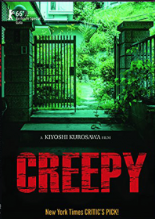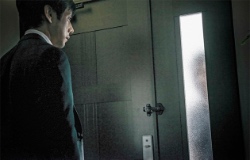
 Horror comes to Shochiku for the venerable Japanese studio’s 120th anniversary with Kiyoshi Kurosawa’s aptly named Creepy, a mystery-thriller purposely too close for comfort.
Horror comes to Shochiku for the venerable Japanese studio’s 120th anniversary with Kiyoshi Kurosawa’s aptly named Creepy, a mystery-thriller purposely too close for comfort.
While we’re on the topic of anniversaries, one year has passed since the police detective Takakura (Hidetoshi Nishijima, Kazuo Umezu’s Horror Theater) nearly was killed by a crazed suspect during an unsuccessful hostage negotiation. Now a university professor of criminal psychology, Takakura and his homemaker wife, Yasuko (Yûko Takeuchi, Ringu), make a fresh start by moving homes. The neighborhood doesn’t exactly roll out the welcome wagon. In fact, the guy next door, Nishino (Teruyuki Kagawa of Takashi Miike’s Sukiyaki Western Django), possesses such abhorrent social skills that it is he from which the film draws its name.
 As Nishino unnerves the couple with his sheer awkwardness, unusually acting daughter (Ryôko Fujino, Solomon’s Perjury) and seemingly nonexistent wife, Takakura learns of an unsolved crime in a nearby town, in which three family members disappeared, leaving behind one very perplexed middle schooler (Haruna Kawaguchi, Screaming Class). Suspicious “as hell” and unable to leave the itch of his old profession unscratched, Takakura secretly teams with a former colleague (Masahiro Higashide, Parasyte: Part 1) to investigate the cold case.
As Nishino unnerves the couple with his sheer awkwardness, unusually acting daughter (Ryôko Fujino, Solomon’s Perjury) and seemingly nonexistent wife, Takakura learns of an unsolved crime in a nearby town, in which three family members disappeared, leaving behind one very perplexed middle schooler (Haruna Kawaguchi, Screaming Class). Suspicious “as hell” and unable to leave the itch of his old profession unscratched, Takakura secretly teams with a former colleague (Masahiro Higashide, Parasyte: Part 1) to investigate the cold case.
Perhaps best known for 2001’s Pulse (which spawned 2006’s deficient Hollywood remake), Kurosawa is almost diabolical in his setup, taking delight in taking his time in winding us up the way a rubber band loops around a pencil. Once he lets go, after the first of two hours passes, the twists come fast and loose. Unfortunately, his handle on the material (which he co-adapted from the Yutaka Maekawa novel) escapes him, and incredulity shoves craft aside.
Ultimately, the Creepy vibe decomposes to the level of being merely languid, all because the final act has been built atop a wobbly, half-Shyamalan shock that simply does not work because it is completely out of character, at least from the information the viewer has been given. I’m surprised that a filmmaker with Kurosawa’s experience and reputation even would entertain the notion of trying to squeak it past his sophisticated audience. Then again, our lead character of Takakura isn’t much better, failing to see the forest for the trees, even when they’re labeled, respectively, “FOREST” and “TREES.” —Rod Lott
